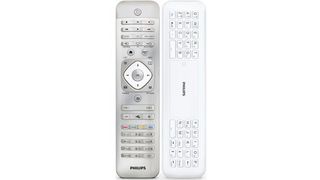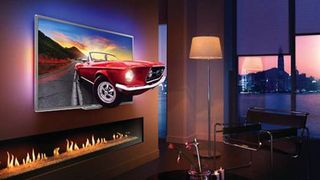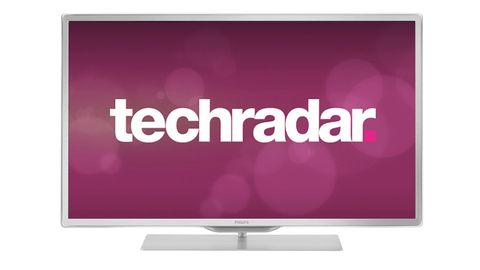Why you can trust TechRadar
We realise that smart TV is largely about convenience and catch-up TV that's most important in the living room, but anyone prepared to spend £2,500 (around AU$3,833/US$4,029) on a TV will probably expect a more polished smart TV platform than the Philips 46PFL9707 provides.
Called Net TV and Smart TV depending on where you look, the Philips 46PFL9707' app platform is accessed either from the TV's central carousel of icons, or via a shortcut on the remote.
Pleasingly it now includes a 'Now on TV' thumbnail with audio that's about 1/6 of the size of the screen, though the effect is tempered by the inclusion of an advert for one of the available apps.

The home screen also includes the date, time, outside temperature and a basic icon representing the weather. There's even a Twitter icon in the top-right of the live TV thumbnail, though when we selected it the Philips 46PFL9707 showed us a pop-up blank screen. We didn't Tweet that.
Apps, arranged along the bottom of the screen, are in two chunks; the first contains icons for an App Gallery, Social TV, BBC iPlayer, a web browser, Facebook, Acetrax, Absolute Radio, YouTube, Napster, Aupeo radio and CNBC Real-Time.
The second panel, which needs navigating to, comprises Picasa, Viewster, Euronews, Meteonews, iConcerts, Screendreams, Funspot and CineTrailer. Luckily there are Fasttext commands to move, lock and remove apps, so it's easy to customize Net TV.

However, the best is yet to come; select the blue Fasttext button and the remote magically turns into a Nintendo Wii-style pointer. It works really well; it's fast, accurate and responsive - but it sadly only works on this apps screen, and not with the TV's core user interface.
With this in mind the double-sided remote control - which sports a full QWERTY keyboard on one side - might seem like overkill. It's primarily for operating the open web browser found on Net TV, though that's still not as slick as on the smartphone most of us have in our pockets.
One 'missing' app, Skype, is found on the Philips 46PFL9707's core user interface away from Net TV. Powered by an optional add-on TV camera, Skype sits on the end of a slick new interface that's built around a simple carousel of icons for all main TV functions.

There's also a new My Remote app for (iOS and Android) smartphones.
Ambilight we've already explained, but what's Moth Eye? It's a contrast-boosting filter deep down in the panel's construction, a nanostructure that takes its inspiration from the way insects' eyes are constructed so as to avoid giving away their location to predators. By blocking out light, says Philips, the filter deepens black tones and boosts peak whites without the usual side-effect of haloing.
Expect to see this tech used on other brand's TVs very soon - as well as on TVs lower down in Philips' ranges in 2013.

Meanwhile, endemic to this direct LED panel's skills at creating both black and brightness are two slabs of technology; Bright Pro and Micro Dimming Premium.
Elsewhere the Philips 46PFL9707 is similarly advanced, with its Pixel Perfect HD suite of picture processing tech including Clear LCD to remove blur from fast-moving images. An 'ISF expert settings' menu is also available for ambitious tweakers, with options to alter gamma, video contrast, and colour temperature.
It's no surprise that the Philips 46PFL9707 uses what Philips calls 3D Max, an active shutter array, though unusually there's a choice between Flicker Free and Maximum Clarity. More about that later.

Our sample arrived with two pairs of Philips PTA507 3D specs, which recharge using a USB cable.
Ins and outs are plentiful. Along the bottom on the TV set's connectivity panel is a 15-pin D-sub input for hooking up a PC, a Scart (via an adaptor), RF in, a USB port and three HDMI inputs, while just above that line-up is a LAN port and three adaptor points for composite video, component video and phonos.
On the side, though still comfortably withdrawn from the edge of the TV, are two more HDMI inputs - taking the total count to an unbeatable five - alongside two more USB slots, a digital optical audio output, headphones slot, and a Common Interface sot.

Jamie is a freelance tech, travel and space journalist based in the UK. He’s been writing regularly for Techradar since it was launched in 2008 and also writes regularly for Forbes, The Telegraph, the South China Morning Post, Sky & Telescope and the Sky At Night magazine as well as other Future titles T3, Digital Camera World, All About Space and Space.com. He also edits two of his own websites, TravGear.com and WhenIsTheNextEclipse.com that reflect his obsession with travel gear and solar eclipse travel. He is the author of A Stargazing Program For Beginners (Springer, 2015),

Amazon Prime Video's disappearing act could point to a future without the service

Tesla Cybertruck suffers new recall for a very scary problem

'The party is over for developers looking for AI freebies' — Google terminates Gemini API free access within months amidst rumors that it could charge for AI search queries

